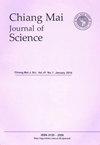拮抗酵母菌生物防治青花菌环斑病
IF 0.8
4区 综合性期刊
Q3 MULTIDISCIPLINARY SCIENCES
引用次数: 0
摘要
本研究利用拮抗酵母对重要的农业病原菌——油菜互交菌(Alternaria brassicola)引起的油菜环斑病进行了生物防治研究。从38种果蔬叶片中分离到115株酵母。用双培养法分离的29株酵母菌对甘蓝芽孢杆菌的抑制活性均在50%以上。结果表明,拮抗酵母菌Y107、Y123和Y16的抑菌率分别为75.00%、73.52%和70.33%。有趣的是,这些酵母在12 h后对甘蓝芽孢杆菌孢子萌发的抑制作用在80.90 ~ 90.26%之间。随后,在大棚试验了所选拮抗酵母菌对大白菜和小白菜的环斑病防治效果。结果表明,拮抗酵母菌Y107对白菜和白菜的抑制率分别为72.75%和71.42%。而分离菌株Y123和Y16对大白菜(66.67%和66.08%)和白菜(69.83%和68.92%)的抑制效果均不显著。此外,通过大亚单位核糖体RNA (LSU)基因D1/D2结构域的系统发育分析,鉴定了拮抗酵母菌分离株。分离物Y16和Y123为槲皮库兹曼氏菌,分离物Y107为泰国汉森氏菌。本文章由计算机程序翻译,如有差异,请以英文原文为准。
Biological Control of Brassicales Ring Spot Disease Caused by Alternaria brassicicola Using Antagonistic Yeasts
T his research investigated the biological control of Ring Spot Disease of Brassicales caused by Alternaria brassicicola, which is an agriculturally important pathogen, using antagonistic yeasts. One hundred fifteen yeasts were isolated from 38 fruits and vegetable leaves. A total of twenty-nine yeast isolates showed the inhibitory activity of A. brassicicola more than a value of 50% by the dual culture method. The result showed that three antagonistic yeast isolates Y107, Y123, and Y16 showed high inhibitory percentages at 75.00%, 73.52%, and 70.33%, respectively. Interestingly, these yeasts inhibited spore germination of A. brassicicola after 12 h within the range of 80.90 to 90.26%. Subsequently, the efficacy of the selected antagonistic yeast against Ring Spots Disease on cabbage seedlings (Brassica oleracea L. var. capitata) and Pak choi (Brassica chinensis L. var. chinensis) was tested in the greenhouse. The result indicated that antagonistic yeast isolate Y107 inhibited the disease at 72.75% and 71.42% in Cabbage seedlings and Pak choi, respectively. However, the efficacy of isolates Y123 and Y16 were not significant in disease inhibition in both Cabbage seedlings (66.67% and 66.08%) and Pak choi (69.83% and 68.92%). Additionally, the antagonistic yeast isolates were identified by phylogenetic analysis of the D1/D2 domain of the large subunit ribosomal RNA (LSU) gene. Yeast isolates Y16 and Y123 were identified to Kurtzmaniella quercitrusa, while isolate Y107 was Hanseniaspora thailandica.
求助全文
通过发布文献求助,成功后即可免费获取论文全文。
去求助
来源期刊

Chiang Mai Journal of Science
MULTIDISCIPLINARY SCIENCES-
CiteScore
1.00
自引率
25.00%
发文量
103
审稿时长
3 months
期刊介绍:
The Chiang Mai Journal of Science is an international English language peer-reviewed journal which is published in open access electronic format 6 times a year in January, March, May, July, September and November by the Faculty of Science, Chiang Mai University. Manuscripts in most areas of science are welcomed except in areas such as agriculture, engineering and medical science which are outside the scope of the Journal. Currently, we focus on manuscripts in biology, chemistry, physics, materials science and environmental science. Papers in mathematics statistics and computer science are also included but should be of an applied nature rather than purely theoretical. Manuscripts describing experiments on humans or animals are required to provide proof that all experiments have been carried out according to the ethical regulations of the respective institutional and/or governmental authorities and this should be clearly stated in the manuscript itself. The Editor reserves the right to reject manuscripts that fail to do so.
 求助内容:
求助内容: 应助结果提醒方式:
应助结果提醒方式:


